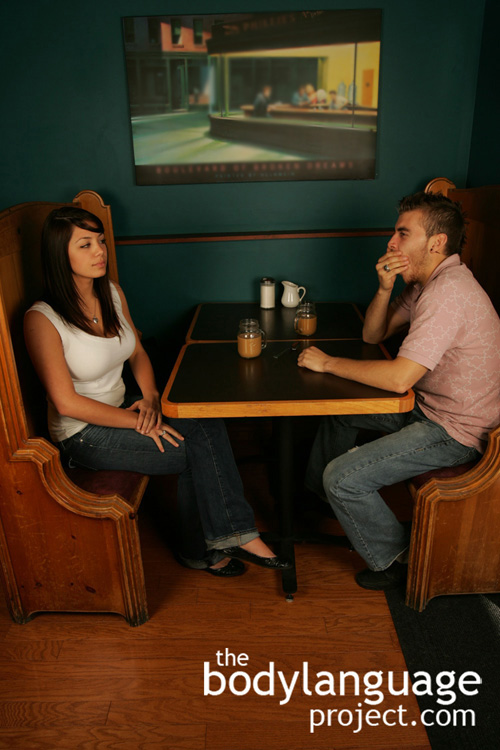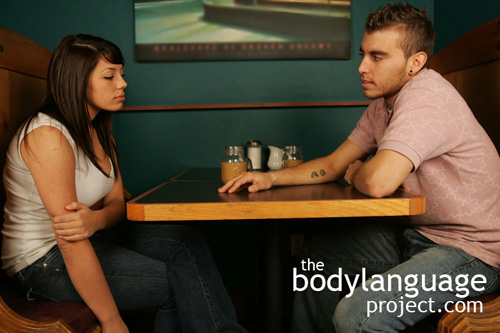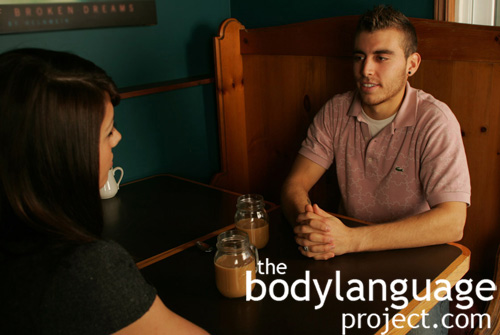Body Language Of Self-Hugging or The Double Arm Hug

 Cue: Self-Hugging or The Double Arm Hug.
Cue: Self-Hugging or The Double Arm Hug.
Synonym(s): Self-Administered Hug, Double Arm Hug, Hugging The Self.
Description: Self-hugging can be done by grabbing both arms across the body, in extreme cases to each shoulder, or by clasping one arm onto the arm, elbow or shoulder on the opposite side (Partial Arm Cross or Incomplete Arm Cross). At times, the hands will pacify by rubbing the shoulders.
In One Sentence: Self hugging is a cue signaling the desire to be comforted.
How To Use it: Self hugging replaces the need for the comfort of another. Thus, it is to be used when one does not wish to rely on the care of others, but when one still wishes to receive a caring touch. The cue is generally perceived in a negative light so should be used only in instances when one is not concerned with appearing vulnerable. Self-hugging in a business meeting, for example, is ill advised. However, hugging the self is perfectly acceptable in the privacy of your own home, or when surrounded by close friends or family where we are generally permitted to show our softer side.
Context: General.
Verbal Translation: “I’m awkward and self conscious so I’m wrapping myself up in a self embrace to provide comfort and care as my parents provided to me in my youth.”
Variant: See Partial Arm Cross or Incomplete Arm Cross, Fetal Position (The), Self-Stroking or Auto Contact, Hand Gripping Upper Arm or Wrist Behind Back.
Cue In Action: It was the first time away from her parents at camp and most of the other girls were getting along fine and seemed to know each other from last year. Autumn was left by herself in line and looked awkwardly at the others while wrapping her arms around herself in a self hug. She was reminded of the care she got from her parents.
Meaning and/or Motivation: Hugging one’s self is both defensive and a closed body position. People who hold this posture exclaim that they are cold, but in reality, the cold sensation stems from feeling awkward, timid, self conscious, or distress. Self-hugs, done in this way, remind us of the care and comfort we received from mom and dad, and when found in adulthood, indicate a need for reassurance.
In adulthood, self-hugging is found when we’re insecure, self-conscious, afraid or defensive, generally. Because it’s generally not appropriate to show vulnerability to others and seek support from other’s we instead hug ourselves discreetly. The astute body language reader will notice this signal and step in to help make the carrier of the signal feel better.
Cue Cluster: Watch for submissive cues to accompany the self-hug such as head lowered or bowed, eyes up-cast, shoulders hunched over and toes pointed inward.
Body Language Category: Amplifier, Appease, Barriers, Body cross, Body size reduction, Blocking or Shielding, Comfort body language, Clenching and gripping, Closed body language, Defensive body language, Emotional body language, Low confidence body language, Nervous body language, Pseudo-infantile gestures, Pacifying body language, Protective reflexes, Submissive body language.
Resources:
Barroso, Felix ; Feld, Jason. Self-touching and attentional processes: The role of task difficulty, selection stage, and sex differences. Journal of Nonverbal Behavior. 1986. 10(1): 51-64.
Bouras, N. ; Dykens, E. M. ; Smith, A. C. M. Distinctiveness and correlates of maladaptive behaviour in children and adolescents with Smith–Magenis syndrome
Journal of Intellectual Disability Research. 1998. 42(6): 481-489.
Broome, Marion E.. Helping Parents Support Their Child In Pain. Pediatric Nursing. 2000. 26(3): 315.
Bornstein, Marc H. ; Tamis-Lemonda, Catherine S. Maternal responsiveness and infant mental abilities: Specific predictive relations. Infant Behavior and Development. 1997. 20(3): 283-296.
Bernal, Gilda Rios ; Wortham, Suec. How to Calm Children through Massage. Childhood Education. 1997. 74(1): 9-14.
Bouhuys, A.L. ; Jansen, C.J. ; van den Hoofdakker, R.H. Analysis of observed behaviors displayed by depressed patients during a clinical interview: relationships between behavioral factors and clinical concepts of activation. Journal of Affective Disorders. 1991. 21(2): 79-88.
Bouhuys, A.L. ; Beersma, Domien G.M. ; van den Hoofdakker, Rutger H. Observed behavior as a predictor of the response to sleep deprivation in depressed patients. Psychiatry Research. 1989. 28(1): 47-61.
Berridge CW,Mitton E, ClarkW, Roth RH. 1999. Engagement in a non-escape (displacement) behavior elicits a selective and lateralized suppression of frontal cortical dopaminergic utilization in stress. Synapse 32:187–197.
Bond, Michael H., and Hiroshi Komai (1976). “Targets of Gazing and Eye Contact During Interviews: Effects on Japanese Nonverbal Behavior.” In Journal of Personality and Social Psychology (Vol. 34), pp. 1276-84.
Blakeslee, Sandra (1995). “In Brain’s Early Growth, Timetable Maybe Crucial.” In New York Times (“Science Times,” August 29), pp. C1, C3.
Caplovitz Barrett, Karen. The origins of social emotions and self-regulation in toddlerhood: New evidence. Cognition & Emotion. 2005. 19(7): 953-979.
Castles, Duncan L. ; Whiten, Andrew ; Aureli, Filippo. Social anxiety, relationships and self-directed behaviour among wild female olive baboons. Animal Behaviour. 1999. 58(6): 1207-1215.
D’alessio, M. ; Zazzetta, A. Development of Self-Touching Behavior in Childhood. Perceptual and Motor Skills. 1986. 63(1): 243-253.
Derlega, Valerian ; Lewis, Robin ; Harrison, Scott ; Winstead, Barbara ; Costanza, Robert. Gender differences in the initiation and attribution of tactile intimacy. Journal of Nonverbal Behavior. 1989. 13(2): 83-96.
Derlega, Valerian J. ; Catanzaro, Diane ; Lewis, Robin J. Lisak, David (editor). Perceptions About Tactile Intimacy in Same-Sex and Opposite-Sex Pairs Based on Research Participants’ Sexual Orientation. Psychology of Men & Masculinity, 2001, Vol.2(2), pp.124-132.
Ekman, Paul, and Wallace V. Friesen (1969). “Nonverbal Leakage and Clues to Deception.” In Psychiatry (Vol. 32), pp. 88-106.
Fromme, Donald ; Jaynes, William ; Taylor, Deborah ; Hanold, Elaine ; Daniell, Jennifer ; Rountree, J. ; Fromme, Marie. Nonverbal behavior and attitudes toward touch. Journal of Nonverbal Behavior. 1989. 13(1): 3-14.
Floyd, Kory. All Touches are not Created Equal: Effects of Form and Duration on Observers’ Interpretations of an Embrace. Journal of Nonverbal Behavior. 1999. 23(4): 283-299.
Goodall, Jane (1986). The Chimpanzees of Gombe: Patterns of Behavior (Cambridge: Belknap Press of Harvard University).
Givens, David B. (1976). An Ethological Approach to the Study of Human Nonverbal Communication (University of Washington Ph.D. dissertation in Anthropology, Ann Arbor: University Microfilms).
Grand, Stanley (1977). “On Hand Movements During Speech: Studies of the Role of Self-Stimulation in Communication Under Conditions of Psychopathology, Sensory Deficit, and Bilingualism.” In Norbert Freedman and Stanley Grand, eds., Communicative Structures and Psychic Structures: A Psycholanalytic Interpretation of Communication (New York: Plenum Press), pp. 199-221.
Goldberg, Shelly ; Rosenthal, Robert. Self-touching behavior in the job interview: Antecedents and consequences. Journal of Nonverbal Behavior. 1986. 10(1): 65-80.
Garnefski N 2004) Cognitive emotion regulation strategies and depressive symptoms: differences between males and female. Personal Indiv Diff 36: 267–76.
Huflejt-Łukasik M, Czarnota-Bojarska J (2006) Short Communication: Selffocused attention and self-monitoring influence on health and coping with stress. Stress Health 22: 153–59.
Hadi, Rhonda ; Valenzuela, Ana. A meaningful embrace: Contingent effects of embodied cues of affection. Journal of Consumer Psychology, 2014, Vol.24(4), pp.520-532.
Harrigan, Jinni A. Self-touching as an indicator of underlying affect and language processes. Social Science & Medicine. 1985. 20(11): 1161-1168.
Harrigan, Jinni A.; Karen S. Lucic; Denise Kay; Anne McLaney and Robert Rosenthal. Effect of Expresser Role and Type of Self-Touching on Observers’ Perceptions. Journal of Applied Social Psychology. 1991. 21(7): 585-609.
Heaven, Laura ; Mcbrayer, Dan ; Prince, Bob. Role of sex in externally motivated self-touching gestures. Perceptual and motor skills. 2002. 95(1): 289-94.
Heaven, L ; Mcbrayer, D. External motivators of self-touching behavior. Perceptual and motor skills. 2000. 90(1): 338-42.
Hall, Jeffrey A. and Chong Xing. The Verbal and Nonverbal Correlates of the Five Flirting Styles. Journal of Nonverbal Behavior. 2015. 39:41–68. DOI 10.1007/s10919-014-0199-8
http://bodylanguageproject.com/articles/first-12-minutes-flirting-using-nonverbal-communication-study-reveals-26-body-language-cues-attraction/
Hall, Judith ; LeBeau, Lavonia ; Reinoso, Jeannette ; Thayer, Frank. Status, Gender, and Nonverbal Behavior in Candid and Posed Photographs: A Study of Conversations Between University Employees. Sex Roles. 2001 44(11): 677-692.
Heino, William J. Perfect Timing for Parental Hugs.(to comfort children following medical treatment)(Brief Article). Consultant. 2000. 40(13): 2173.
Katza, Carmit; Irit Hershkowitz; Lindsay C. Malloya; Michael E. Lamba; Armita Atabakia and Sabine Spindlera. Non-Verbal Behavior of Children Who Disclose or do not Disclose Child Abuse in Investigative Interviews. Child Abuse & Neglect. 2012. 36: 12-20.
http://bodylanguageproject.com/articles/reading-nonverbal-behaviour-child-abuse-cases-encourage-children-divulge-information-truth-telling
Kenner, Andrew N. (1993). “A Cross-Cultural Study of Body-Focused Hand Movement.” In Journal of Nonverbal Behavior (Vol. 17, No. 4, Winter), pp. 263-79.
Kochanska, G., Coy, K. C., & Murray, K. T. (2001). The development of self-regulation in the first four years of life. Child Development, 72, 1091–1111.
Kochanska, G., Murray, K. T., & Harlan, E. T. (2000). Effortful control in early childhood: Continuity and change, antecedents, and implications for social development. Developmental Psychology, 36, 220–232.
Kirschbaum C, Pirke K-M, Hellhammer DH. 1993. The ‘Trier Social Stress Test’: a tool for investigating psychobiological stress responses in a laboratory setting. Neuropsychobiology 28: 76–81.
Lee Ann Renninger, T. Joel Wade, Karl Grammer. Getting that female glance: Patterns and consequences of male nonverbal behavior in courtship contexts. Evolution and Human Behavior. 2004; 25: 416–431.
http://bodylanguageproject.com/articles/part-i-how-to-read-male-sexual-body-language-a-study-for-women-and-the-men-who-wish-to-cheat-the-system/
Mohiyeddini, Changiz ; Semple, Stuart. Displacement behaviour regulates the experience of stress in men. Stress. 2013. 16(2): 163-171.
Moszkowski, Robin J. ; Stack, Dale M. ; Chiarella, Sabrina S. Infant touch with gaze and affective behaviors during mother–infant still-face interactions: Co-occurrence and functions of touch. Infant Behavior and Development. 2009. 32(4): 392-403.
Maestripieri D, Schino G, Aureli F, Troisi A. 1992. A modest proposal: displacement activities as an indicator of emotions in primates. Anim Behav 44:967–979.
Mohiyeddini, C., Bauer, S., & Semple, S. (2013a). Displacement behaviour is associated with reduced stress levels among men but not women. PLoS One, 8, e56355.
Mohiyeddini, C., Bauer, S., & Semple, S. (2013b). Public self-consciousness moderates the link between displacement behaviour and experience of stress in women. Stress, 16, 384–392.
Mohiyeddini, C., & Semple, S. (2013). Displacement behaviour regulates the experience of stress in men. Stress, 16, 163–171.
Marcus-Newhall A, Pedersen WC, Carlson M, Miller N. 2000. Displaced aggression is alive and well: a meta-analytic review. J Pers Soc Psychol 78:670–689. Ingram GIC. 1960. Displacement activity in human behavior. Am Anthropol. 62:994–1003.
Morris, Desmond (1994). Bodytalk: The Meaning of Human Gestures (New York: Crown Publishers).
McGrew, W. C. (1972). “Aspects of Social Development in Nursery School Children with Emphasis on Introduction to the Group.” In N. G. Blurton Jones, ed., Ethological Studies of Child Behaviour (Cambridge: University Press), pp. 129-56.
Navarro, Joe. 2008. What Every BODY is Saying: An Ex-FBI Agent’s Guide to Speed-Reading People. William Morrow Paperbacks.
Nolen-Hoeksema S, Aldao A (2011) Gender and age differences in emotion regulation strategies and their relationship to depressive symptoms. Personal Indiv Diff 51: 704–8.
Pugh, George E. (1977). The Biological Origin of Human Values (New York: Basic Books).
Rosenfeld, Howard (1973). “Nonverbal Reciprocation of Approval: An Experimental Analysis.” In Argyle *, pp. 163-72.
Rule, Nicholas, O.; Reginald B. Adams Jr.; Nalini Ambady and Jonathan B. Freeman. Perceptions Of Dominance Following Glimpses Of Faces And Bodies. Perception. 2012; 41: 687-706 doi:10.1068/p7023
http://bodylanguageproject.com/articles/people-can-read-dominance-split-second
Rabinowitz, Fredric E. The male-to-male embrace: breaking the touch taboo in a men’s therapy group. Journal of Counseling and Development. 1991. 69(6): 574(3).
Shimooka, Yukiko ; Nakagawa, Naofumi. Functions of an unreported “rocking-embrace” gesture between female Japanese Macaques ( Macaca fuscata ) in Kinkazan Island, Japan. Primates. 2014. 55(2): 327-335.
Schaafsma, Juliette ; Krahmer, Emiel ; Postma, Marie ; Swerts, Marc ; Balsters, Martijn ; Vingerhoets, Ad. Comfortably Numb? Nonverbal Reactions to Social Exclusion. Journal of Nonverbal Behavior. 2015. 39(1): 25-39.
Sommer, Robert (1969). Personal Space: The Behavioral Basis of Design (Englewood Cliffs, New Jersey: Prentice-Hall).
Schino G, Perretta G, Taglioni AM, Monaco V, Troisi A. 1996. Primate displacement activities as an ethopharmacological model of anxiety. Anxiety 2:186–191.
Supplee, Lauren H ; Skuban, Emily Moye ; Shaw, Daniel S ; Prout, Joanna. Emotion regulation strategies and later externalizing behavior among European American and African American children. Development and Psychopathology. 2009. 21(2): 393-415.
Taavoni, S ; Shahali, S ; Haghani, H. Infant Vaccination Pain Management: Comparing the Effect of Mother’s Hug and Breast Feeding, Tehran, 2009-2010. Pediatric Research. 2011. 70: 738-738.
Tamres L, Janicki D, Helgeson VS (2002) Sex differences in coping behaviour: a
meta-analytic review. Personal Soc Psychol Rev 6: 2–30.
Troisi A (2002) Displacement activities as a behavioural measure of stress in nonhuman primates and human subjects. Stress 5: 47–54.
Troisi A (1999) Ethological research in clinical psychiatry: the study of nonverbal behaviour during interviews. Neurosci Biobehav Rev 23: 905–913.
Troisi A, Moles A (1999) Gender differences in depression: an ethological study of nonverbal behaviour during interviews. J Psychiatr Res 33: 243–250.
Vannorsdall, Tracy ; Dahlquist, Lynnda ; Shroff Pendley, Jennifer ; Power, Thomas. The Relation Between Nonessential Touch and Children’s Distress During Lumbar Punctures. Children’s Health Care. 2004. 33(4): 299-315.
von Hippel W, von Hippel C, Conway L, Preacher KJ, Schooler JW, et al. (2005) Coping with stereotype threat: denial as an impression management strategy. J Personal Soc Psychol 89: 22–35.










